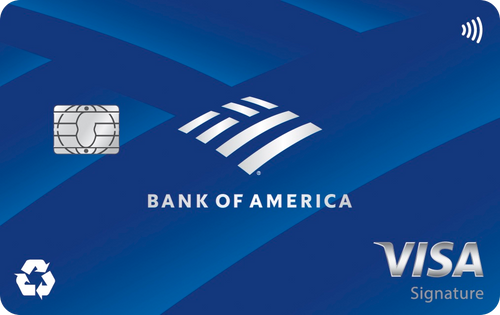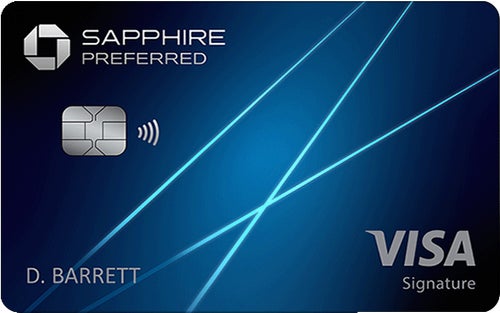Summary
Our card comparison helps you decide whether you should go with Bank of America’s simple travel rewards card or splurge on the Chase Sapphire Preferred with its $95 annual fee.
The content on this page is accurate as of the posting date; however, some of our partner offers may have expired. Please review our list of best credit cards, or use our CardMatch™ tool to find cards matched to your needs.
If you’re looking for a new travel credit card, one of the first questions to ask yourself is how much money you’re willing to invest. Do you mind paying an annual fee so you can earn more travel rewards and other high-value benefits? Or do you prefer a travel card with no annual fee?
Deciding how much you’re willing to pony up for a new travel card should help you narrow down your options. The Chase Sapphire Preferred Card has long been a favorite of travel card enthusiasts, thanks to its generous rewards program, flexible redemption options and strong travel benefits.
Cardholders earn 3X points for every dollar they spend on dining purchases and 2X points on general travel purchases. But the Sapphire Preferred card costs $95 a year, so you may want to look elsewhere if you’re hesitant to commit to a yearly fee.
The Bank of America® Travel Rewards credit card, on the other hand, doesn’t offer quite as much value. But with a strong spending bonus on every purchase and a flexible rewards program, it’s one of the best – and least complicated – no-annual-fee travel cards around.
Bank of America Travel Rewards vs. Chase Sapphire Preferred
| Card |  |  |
| Rewards rate | 1.5X points on all purchases |
|
| Sign-up bonus | 25,000 points if you spend $1,000 in the first 90 days | 60,000 points if you spend $4,000 in the first three months |
| Annual fee | $0 | $95 |
| Estimated yearly rewards value (for someone who spends $15,900) | $322 | $376 |
| Pros |
|
|
| Cons |
|
|
| Who should get this card? |
|
|
Best card for someone who doesn’t want to pay an annual fee: Bank of America Travel Rewards
If you aren’t comfortable paying an annual fee, your choice should be fairly easy: The Bank of America Travel Rewards card is a solid no-annual-fee travel card.
Similar to its competitors – Discover it® Miles and the Capital One Quicksilver Cash Rewards Credit Card – the Bank of America Travel Rewards credit card offers a solid bonus on every purchase and hassle-free redemption without an annual commitment.
But before you dismiss premium cards completely, you may want to give the Chase Sapphire Preferred card a closer look. Depending on how much money you spend each year on travel and dinners out, you may be able to recoup the card’s $95 annual fee relatively easily.
Best card for someone who wants a big sign-up bonus: Chase Sapphire Preferred
You’ll also get more value in the first year with the Chase Sapphire Preferred card, even if you travel just a few times a year.
Chase offers a 60,000-point bonus – worth up to $750 in travel when redeemed with Chase – if you spend $4,000 in the first three months. Charging roughly $1,334 a month for three months in a row can be a difficult bar to clear, especially if you’re usually a more modest spender. But if you can afford to charge that much in a three-month time period, then it’s a great deal.
The Bank of America Travel Rewards card’s sign-up bonus is more modest; however, it’s also more accessible. The card offers a 25,000-point bonus – worth up to $250 in travel – if you spend just $1,000 in the card’s first 90 days.
That’s significantly less than the bonus offered by the Chase Sapphire Preferred card, but it’s a strong offer for a card that doesn’t charge an annual fee.
Best card for heavy travelers: Chase Sapphire Preferred
Where the Chase Sapphire Preferred card really shines, though, is in its rewards programs. A longtime favorite of travel hackers, the Chase Sapphire Preferred card is much more lucrative for frequent travelers – especially if you’re a frequent flyer and regularly fly or stay with Chase travel partners, such as British Airways, United, Southwest Airlines, Hyatt or Marriott.
Unlike the Bank of America Travel Rewards credit card, the Chase Sapphire Preferred lets you transfer your points on a one-to-one basis to a wide variety of Chase travel partners. Depending on which hotel or airline you choose, transferring your points to another loyalty program can potentially make your points much more valuable.
For example, if you use your points to purchase travel through Chase’s Ultimate Rewards portal, each point will be worth 1.25 cents. But if you transfer your points to a hotel or airline loyalty program, your points could be worth anywhere from 1.5 cents to more than 2 cents each.
According to our estimates, a Chase Ultimate Rewards point that’s converted to a British Airways Avios mile is worth 1.4 cents, while an Ultimate Rewards point converted to a Hyatt point is worth up to 2 cents each. A Bank of America Travel Rewards point, by contrast, is worth just 1 cent each.
Even frequent flyers who prefer to redeem their travel through Chase’s Ultimate Rewards portal rather than transfer their points to another program will still earn more using the Sapphire Preferred card.
For example, if you charged $20,000 a year on hotel, airfare and other travel purchases, you’d earn 100,000 points using the Sapphire card, which translates to roughly $800 in value. With the Bank of America Travel Rewards card, by contrast, you’d earn just $300 worth of travel.
| Rewards earnings on $20,000 in travel purchases in the first year | |
| Bank of America Travel Rewards | Chase Sapphire Preferred |
| $20,000 x 1.5 points x 1 cent per point = $300 | $20,000 x 5 points x 1.25 cents per point = $800 |
Chase also provides a fair number of opportunities for earning travel points, not just when you’re booking a flight or a hotel. For example, you can earn bonus points on toll fees, taxi fares, public transportation and more.
Best card for someone who wants a low-maintenance travel card: Bank of America Travel Rewards
If you just want a simple, low-maintenance travel card, you may prefer the Bank of America Travel Rewards.
Unlike the Sapphire Preferred, you don’t need to track which purchases earn a spending bonus, nor do you need to go through your card issuer to redeem your points for travel. All you have to do is charge purchases to your card and automatically collect 1.5 points for every dollar you spend.
Then, when it’s time to redeem your points for travel, you can use your card to book your travel through any website you choose – including third-party discount sites, such as Hotwire and Orbitz – and request a statement credit for whatever you spent. Bank of America will even give you up to 12 months to request a refund, so you don’t need to rush to get repaid.
Best card for occasional travelers: Bank of America Travel Rewards
The Bank of America Travel Rewards may also make more sense for you if you travel only occasionally. By offering 1.5 points for every dollar you spend, it’s a great everyday card you can use for a wide variety of purchases.
That could lead to higher earnings overall if you travel only one or two times a year but regularly charge more than $1,000 a month on miscellaneous purchases.
For example, if you typically spend around $2,000 a year on dining, $1,000 a year on travel and an additional $15,000 a year on miscellaneous purchases, you’ll earn at least $270 worth of travel using the Bank of America card.
With the Sapphire Preferred card, you’d net around $230 worth of travel after paying for the card’s $95 annual fee.
| Rewards earnings on $2,000 on dining, $1,000 on travel and $15,000 on general purchases | |
| Bank of America Travel Rewards | Chase Sapphire Preferred |
| $18,000 x 1.5 points x 1 cent per point = $270 | ($2,000 x 3 points) + ($1,000 x 5 points) + ($15,000 x 1 point) x 1.25 cent per point – $95 annual fee = $230 |
Best card for Bank of America customers: Bank of America Travel Rewards
Bank of America customers with $20,000 to $100,000 or more deposited with the bank can earn anywhere from a 25% rewards bonus to a 75% bonus.
That kind of rewards rate would make a flat-rate card, such as the Bank of America Travel Rewards, a no-brainer, since you would earn as much as 2.625 points for every dollar you charged.
If you’re a heavy traveler, you could even combine this card with the Chase Sapphire Preferred card and use your Bank of America card for non-travel-related purchases and your Chase card for travel and restaurant spending.
| Bonus cash back | Points earned per dollar | |
| No Bank of America account | None | 1.5 |
| Gold customers ($20,000 to $49,999 balance) | 25% | 1.875 |
| Platinum customers ($50,000 to $99,999 balance) | 50% | 2.25 |
| Platinum Honors customers ($100,000+ balance) | 75% | 2.625 |
See related: Guide to Bank of America Preferred Rewards
Bottom line
For most frequent travelers, the Chase Sapphire Preferred card is the best option – even if it has a $95 annual fee.
Its travel rewards program is uniquely generous, especially if you pair it with other travel loyalty programs. Meanwhile, it offers a number of additional perks that are becoming increasingly hard to find, such as premium travel insurance and purchase protection.
If you don’t want to pay an annual fee, however, the Bank of America Travel Rewards card is definitely worth a closer look.
Editorial Disclaimer
The editorial content on this page is based solely on the objective assessment of our writers and is not driven by advertising dollars. It has not been provided or commissioned by the credit card issuers. However, we may receive compensation when you click on links to products from our partners.





